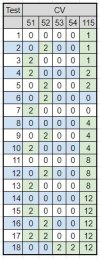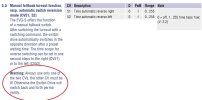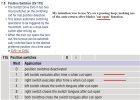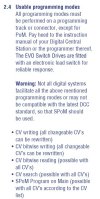Here is the detail, if anyone fancies a go I'd be interested to know what you find.

Thrown is shown as “T”. Closed is shown as “C”.
- X reset to factory default via CV8 -> 8
Test 1 - Left switch executes.
- CV115 -> 1 “left switch executes after time x when cut-open”
- Motor set T -> Motor moves to T. No return
- Motor set C -> Motor moves to C. No return
- Motor set T -> Motor moves to T. Manually move the blade to C. No return.
- Motor set C -> Motor moves to C. Manually move the blade to T. No return
- Manually move blades. No return in either C or T.
Test 2 - Auto return Left, Left switch executes.
- CV52 -> 2 “Time automatic reverse left”
- Motor set T -> Motor moves to T. No return
- Motor set C -> Motor moves to C. Auto timed return to T.
- Motor set T -> Motor moves to T. Manually move the blade to C. No return.
- Motor set C -> Motor moves to C. Manually move the blade to T. Auto timed return to T
- Manually move blades back and forth. No return.
Test 3 - Auto return Right, Left switch executes.
- CV51 -> 2 “Time automatic reverse right”
- CV52 -> 0 “Time automatic reverse left”
- Motor set T -> Motor moves to T. Auto timed return to C.
- Motor set C -> Motor moves to C. No return.
- Motor set T -> Motor moves to T. Manually move the blade to C. Auto timed return to C.
- Motor set C -> Motor moves to C. Manually move the blade to T. Auto timed return to C.
- Manually move blades. Always timed return to C.
Test 4 - Auto return Right, Right switch executes.
- CV115 -> 2 “right switch executes after time x when cut-open”
- Motor set T -> Motor moves to T. Auto timed return to C.
- Motor set C -> Motor moves to C. No return.
- Motor set T -> Motor moves to T. Manually move the blade to C. Auto timed return to C.
- Motor set C -> Motor moves to C. Manually move the blade to T. No return.
- Manually move blades. No return.
Test 5 - Auto return Left, Right switch executes.
- CV51 -> 0 “Time automatic reverse right”
- CV52 -> 2 “Time automatic reverse left”
- Motor set T -> Motor moves to T. No return.
- Motor set C -> Motor moves to C. Auto timed return to T.
- Motor set T -> Motor moves to T. Manually move the blade to C. Auto timed return to T.
- Motor set C -> Motor moves to C. Manually move the blade to T. Auto timed return to T.
- Manually move blades. Always timed return to T.
Test 6 - Auto return Left
- CV115 -> 0 “position switches deactivated”
- Motor set T -> Motor moves to T. No return.
- Motor set C -> Motor moves to C. Auto timed return to T.
- Motor set T -> Motor moves to T. Manually move the blade to C. No return.
- Motor set C -> Motor moves to C. Manually move the blade to T. Auto timed return to T.
- Manually move blades.No return.
Test 7 - Auto return Right
- CV51 -> 2 “Time automatic reverse right”
- CV52 -> 0 “Time automatic reverse left”
- Motor set T -> Motor moves to T. Auto timed return to C.
- Motor set C -> Motor moves to C. No return.
- Motor set T -> Motor moves to T. Manually move the blade to C. Auto timed return to C.
- Motor set C -> Motor moves to C. Manually move the blade to T. No Return.
- Manually move blades.No return.
Observation - when CV115 is set with switches opposite to the return direction in CV51/CV52 (e.g. CV52 > 0, CV115 = 2 Auto return Left, Right switch executes), the motor always returns to the direction set by CV51/CV52. If they are set in the same direction, then the motor only returns on a DCC command.
When CV115 = 0, the auto return function only works via DCC command - manually moving the blades does not work.
Test 8 - Left switch closes
- CV51 -> 0 “Time automatic reverse right”
- CV52 -> 0 “Time automatic reverse left”
- CV115 -> 4 “left switch closes the switch tongues after cut-open”
- Motor set T -> Motor moves to T. No return.
- Motor set C -> Motor moves to C. No return.
- Motor set T -> Motor moves to T. Manually move the blade to C. No Return.
- Motor set C -> Motor moves to C. Manually move the blade to T. Instant return to C.
- Manually move blades. Instant return to C.
Test 9 - Left switch closes, Auto return Left
- CV52 -> 2 “Time automatic reverse left”
- Motor set T -> Motor moves to T. No return.
- Motor set C -> Motor moves to C. Auto timed return to T.
- Motor set T -> Motor moves to T. Manually move the blade to C. No Return.
- Motor set C -> Motor moves to C. Manually move the blade to T. Instant return to C, then timed return to T.
- Manually move blades.
T -> C, No Return.
C -> T,Instant return to C, then timed return to T.
Test 10 - Left switch closes, Auto return Right
- CV51 -> 2 “Time automatic reverse right”
- CV52 -> 0 “Time automatic reverse left”
- Motor set T -> Motor moves to T. Auto timed return to C.
- Motor set C -> Motor moves to C. No Return.
- Motor set T -> Motor moves to T. Manually move the blade to C. Timed return to C.
- Motor set C -> Motor moves to C. Manually move the blade to T. Instant return to C.
- Manually move blades.
T -> C, Instant return to T.
C -> T No Return.
If the manual is to be understood correctly: “When the train cut opens the turnout, the turnout can be automatically switched back to the desired preferred position via a time value in CV51 or CV52”.
Putting a value into CV51 here should set the time for the auto return when the point is cut open. However, it returns on a DCC command and does not do a timed move back to the commanded position.
This is how I would expect it to work:
Desired Effect - Left switch closes after cut open:
CV51 -> 0 “Time automatic reverse right”
CV52 -> 2 “Time automatic reverse left”
CV115 -> 4 “left switch closes the switch tongues after cut-open”
Motor set T -> Motor moves to T. Does not return.
Motor set C -> Motor moves to C. Does not return.
Loco cuts blades T -> C, Timed return to T according to value set in CV52.
Loco cuts blades C -> T, No Return.
 The Shed
might have some pearls of wisdom, or if anyone here knows anything about these motors and how to get this function to work? Have I missed a CV setting somewhere?
The Shed
might have some pearls of wisdom, or if anyone here knows anything about these motors and how to get this function to work? Have I missed a CV setting somewhere? 




